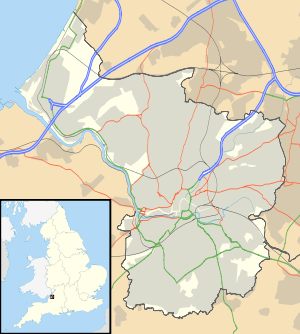The Dutch House, Bristol
| The Dutch House | |
|---|---|
 The Dutch House in 1931 | |
 Location within Bristol | |
| General information | |
| Architectural style | Vernacular |
| Town or city | Bristol |
| Country | England |
| Coordinates | 51°27′18″N 2°35′34″W / 51.454875°N 2.592850°W |
| Completed | 1676 |
| Demolished | 1940, Bristol Blitz |
| Technical details | |
| Structural system | Timber frame |
The Dutch House was a large timber-framed building situated at Nos 1 and 2, High St Bristol, England. It was a well-known local landmark until its destruction in 1940.
History
The Dutch House (often given the prefix 'Old') was built as a private residence in 1676, and dominated the mediaeval crossroads of High St, Wine St, Broad St and Corn St in the heart of ancient Bristol.
The dominant part of the structure was No. 1 High St. This was of rectangular plan, two bays by one, and originally five stories tall; an attic storey was added later. This building had facades on both Wine St and High St. The Wine St façade was two bays wide and consisted of a square bay window to the full height of the original building (except the ground floor), with a flat façade to its right. The High St façade consisted of a bay window, narrower than that on the Wine St façade and with splayed sides, but similar in all other respects. Both facades were ornately carved.
The adjoining house at No.2 High St was incorporated into the premises at some point before 1860. This five-storey gabled house was considerably less ornate than No.1, consisting of full-width square bays to the first and second storeys, and a smaller square bay offset to the left on the third storey. The third storey bay was rebuilt at some point between 1847 and 1866 to make it symmetrical, and the façade of this building was changed by exposing and embellishing its frame to unify it with the rest of the building.
The timber frame of the unified building was at some point reinforced with iron beams.[1]
In 1810 the Dutch House became the Castle Bank, and subsequently had a succession of retail and office uses. By 1866, under the auspices of hatter Mr T.W.Tilly, it had gained fake battlements[2] with cannon, a weather vane, a flagpole and a Grenadier Guardsman sign (now in the care of the City Museum).[3] It seems likely that Mr Tilly was also responsible for altering the façade of No.2. The battlements, incongruous on a timber-framed building, had been removed by 1917.[4]
In the early 1900s traffic engineers planned to demolish the building to ease the flow of traffic between High St and Wine St. These plans were dropped after the Lord Mayor used his casting vote[5] against them, however the lower storey was cut back in 1908 to accommodate the pavement so that the junction could be eased.
The shop's final occupier was the Irish Linen and Hosiery Association.
The building was a well -loved landmark of the city and featured in pre-war guide books and in many photographs and postcards.
The name
The name "The Dutch House" was used from about 1860, when T W Tilly took over the shop. It is thought[6] that he may have given the building the name, and started the story that its timber frame was constructed in Holland and then brought over and assembled in England.
This story does not bear close scrutiny. Both of the original houses, though different in style, reflect the local vernacular; for example the High St facade of No.1 has many similarities with the surviving Llandoger Trow.
Some of Bristol’s timber-framed buildings were however constructed in part from recycled ship’s timbers, so it is not completely out of the question that some of the timber frame may have come from a Dutch ship.
Destruction
On Sunday, 24 November 1940 the Dutch House was badly damaged in an air raid which destroyed much of Bristol's pre-war shopping area. Photographs taken immediately after the raid show that much of the fabric of the building was intact and could possibly have been saved had there been a will to do so. However, on 27 November 1940 an army demolition team completed the destruction. According to an eye-witness account,[7] the demolition took considerable effort.
The site where the building stood is now occupied by a link road connecting Broad Street to the short dual carriageway between High St and Wine St.
References
- ↑ Winstone, Reece: Bristol Blitzed (1973) 900814 43 8 Cover photo, distorted beams visible in upper storeys
- ↑ Winstone, Reece: Bristol as it Was 1866-1860(2nd Edition 1972) 900814 40 3 Plate 24
- ↑ Winstone, Reece: Bristol as it Was 1879-1874 (3rd Edition 1984) 0 900814 64 0 Plates 17 and 22
- ↑ Winstone, Reece: Bristol as it Was 1913-1921 0 900814 48 9 Plate 44
- ↑ http://www.bristolblitzed.org//?page_id=27%20Bristol%20Blitzed:%20The%20Dutch%20House
- ↑ Winstone, Reece Bristol’s Earliest Photographs (1970) 900814 32 2 Caption to plate 50
- ↑ Winstone, Reece: Bristol Blitzed (1973) 900814 43 8 p26
Coordinates: 51°27′18″N 2°35′34″W / 51.45496°N 2.59278°W